

Near East Relief Historical Society. World Muslim Population by Region, 2010 and 2050. Europe. Europe is the second smallest of the seven continents covering roughly 2% of the earth’s surface.

The name 'Europe’ has long been thought to have been derived from the ancient myth of Zeus and Europa. According to this tale, the great god Zeus, seeing the lovely Phoenician princess Europa bathing (or, according to other versions, playing with her handmaidens) by the sea shore, transformed himself into a magnificent white bull and slowly approached her from the sea. So gentle and sweet was this bull that Europa placed garlands of flowers around his neck, petted him and then climbed onto his back when, much to her surprise, the bull ran off across the surface of the seas, abducting her to the isle of Crete. On Crete Zeus and Europa became lovers and she bore him three famous sons. All Empires: Online History Community. History of Iran: Safavid Empire 1502 - 1736. The Early Middle East. The 9,000-year-old underground megalithic settlement of Atlit Yam.
Not far off the coast of the village of Atlit in the Mediterranean Sea, near Haifa in Israel, lies the submerged ruins of the ancient Neolithic site of Atlit Yam.
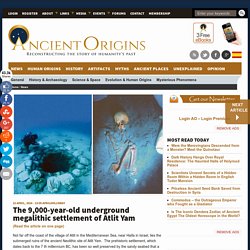
The prehistoric settlement, which dates back to the 7 th millennium BC, has been so well preserved by the sandy seabed that a mysterious stone circle still stands as it was first erected, and dozens of human skeletons lay undisturbed in their graves. Atlit Yam is one of the oldest and largest sunken settlements ever found and sheds new light on the daily lives of its ancient inhabitants. Today, Atlit Yam lies between 8 – 12 metres beneath sea level and covered an area of 40,000 square metres. At the centre of the settlement, seven megaliths (1.0 to 2.1 metres high) weighing up to 600 kilograms are arranged in a stone semicircle. The stones have cup marks carved into them and were once arranged around a freshwater spring, which suggests that they may have been used for a water ritual. What caused Atlit Yam to sink?
Ancient World Alive Blog. The Crusades - home page. Return from the Crusade by Karl Friedrich Lessing Rheinisches Landesmuseum This site is a fully virtual course offered through Boise State University.

The course materials are open to the general public and to other educators. Please see the Visitor Center for details. Visitor Center Classroom Other courses by Knox Western Civilization. How Did the Crusades Affect European Economy? MUHAMMAD ALI BEN MARCUS: THE UNCHRISTIAN CRUSADES 1095 - 2012. GREAT MILITARY BATTLES. At the height of the Assyrian Empire (700 BC) she possessed the most powerful army yet seen in the ancient world, and would go on to dominate the for three hundred years.
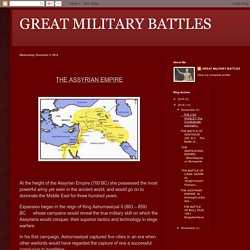
Expansion began in the reign of King Ashurnasirpal II (883 – 859) BC whose campains would reveal the true military skill on which the Assyrians would conquer, their superior tactics and technology in siege warfare. In his first campaign, Ashurnasirpal captured five cities in an era when other warlords would have regarded the capture of one a successful conclusion to hostilities. Ashurnasirpal’s son Shalmaneser III (859 - 824) BC also adopted a policy of conquest. Shalamaneser’s armies defeated an alliance of northern Syrian states at the battle of Lutibu in 858 BC, advancing his northern frontiers into and controlling the important trade routes to .
At Shalameneser’s death, rebellions within the Assyrian heartlands broke out for a period no less than seventy nine years in which time all the western conquests were lost. The Epic of Kings by Ferdowsi. The Internet Classics Archive: 441 searchable works of classical literature. Internet History Sourcebooks.
Internet Ancient History Sourcebook The Internet Ancient History Sourcebook has expanded greatly since its creation, and now contains hundred of local files as well as links to source texts throughout the net.
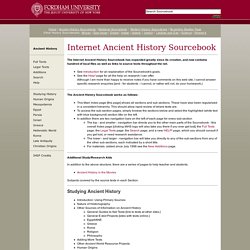
History. 40 maps that explain the Middle East. Maps can be a powerful tool for understanding the world, particularly the Middle East, a place in many ways shaped by changing political borders and demographics.
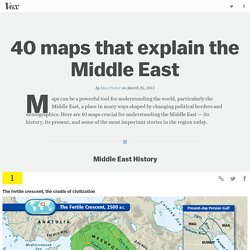
Here are 40 maps crucial for understanding the Middle East — its history, its present, and some of the most important stories in the region today. Middle East History The fertile crescent, the cradle of civilization The fertile crescent, the cradle of civilizationIf this area wasn't the birthplace of human civilization, it was at least a birthplace of human civilization. Called "the fertile crescent" because of its lush soil, the "crescent" of land mostly includes modern-day Iraq, Syria, Jordan, and Israel-Palestine. (Some definitions also include the Nile River valley in Egypt.) Europe. Historians of the Ottoman Empire. Biography of Ataturk (english) THE HISTORY OF THE TURKISH AND OTTOMAN EMPIRE - Discovery History Ancient Culture (full documentary)
Ottoman Empire The War Machine - History Documentary. The Rise and Fall of the Ottoman Empire. Ottoman Empire Facts, information, pictures. OTTOMAN EMPIRE.
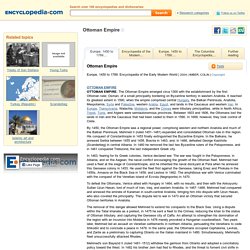
Pre-State Israel. Religions - Islam: Mughal Empire (1500s, 1600s) Religion: Islam. Religions - Islam: Sunni and Shi'a. Religions - Islam: Safavid Empire (1501-1722) Religions - Islam: Ottoman Empire (1301-1922) History of the Ottoman Empire - Decline and Fall. Ottoman history from 1566 -1792 has been described as ”The Decline of Faith and State.”

To Ottomans, " decline ” meant dislocation of the traditional order; hence, ” reforms " to check or reverse " decline " meant restoring the old order which had produced the Golden Age of Suleyman the Magnificent.” At times decline was checked but only temporarily. Decline was not only slow, gradual, interrupted, lasting rnore than three centuries, but also it was relative only to its own Golden Age and to the remarkable progress of its Christian European neighbors. It is easier to describe decline than to explain it. Some developments which the Ottoman Empire did not take part in gave Europe its relative superiority. [ 1 ] Its 16th-10th c. commercial expansion overseas enriched Western Europe to the detriment of the Ottomans.
The Ottomans were more conscious of the dislocations in their own traditional system: In the18th c. more wars and losses resulted in another attempt at reforms. The Rise of the Turks and the Ottoman Empire. The Rise of the Turks and the Ottoman Empire Turkish Origins The first historical references to the Turks appear in Chinese records of about 200 B.C.
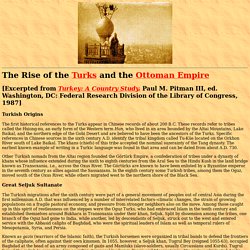
TheOttomans.org - Discover The Ottomans. Rome organized its extensive territory under a proconsul as the province of Asia.
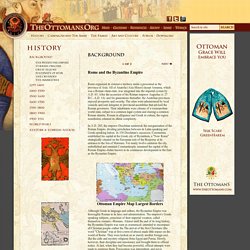
All of Anatolia (Asia Minor) except Armenia, which was a Roman client-state, was integrated into the imperial system by A.D. 43. After the accession of the Roman emperor Augustus (r. 27 B.C. -A.D. 14), and for generations thereafter, the Anatolian provinces enjoyed prosperity and security. The cities were administered by local councils and sent delegates to provincial assemblies that advised the Roman governors. Their inhabitants were citizens of a cosmopolitan world state, subject to a common legal system and sharing a common Roman identity. Ottomania. On the way to the Sultan’s harem, I saw two beautiful slave girls walking across a parking lot clutching their tiaras and squinting unhappily into the sun. It was a hot August day in Istanbul, with an intermittent gusting wind. An attendant ushered me into a warren of royal chambers. I crossed the marble flagstones of a capacious Turkish bath, and proceeded down the passageway known as the Golden Road, through which a lucky concubine, having received the purple handkerchief indicative of the Sultan’s favor, approaches the privy chamber.
On a gilt desk lay an imperial seal and two sticks of wax. Sultan Erdogan: Turkey's Rebranding Into the New, Old Ottoman Empire - Cinar Kiper. Sailing yachts cruise through Bosphorus waterways past Istanbul's Topkapi palace, once a home for Sultans in the Ottoman empire, on July 25, 2000. (Reuters) The cities might not seem similar today, but one thing Tripoli and Thessaloniki, Basra and Beirut, Sarajevo and Sana'a all once had in common is that just a little over a century ago they were all part of the Ottoman Empire. A second thing they all have in common is that until just a few years ago they harbored a certain disdain for Turkey ... due in large part to the aforementioned empire. Yet former rivals to the south, east, north and even west now attend Turkish business summits, watch Turkish shows, and purchase Turkish groceries. Interestingly and perhaps contrary to common sense, this recent shift seems to come not as a product of "time healing old wounds" but rather at a period when Turkey has embraced its Ottoman heritage to an unheard-of level.
The Ottoman Empire. Historical empire, Eurasia and Africa. History of the Ottoman Empire. The Ottoman Empire was founded by Osman I. As sultan Mehmed II conquered Constantinople (today named Istanbul) in 1453, the state grew into a mighty empire. History - World Wars: The Middle East during World War One.